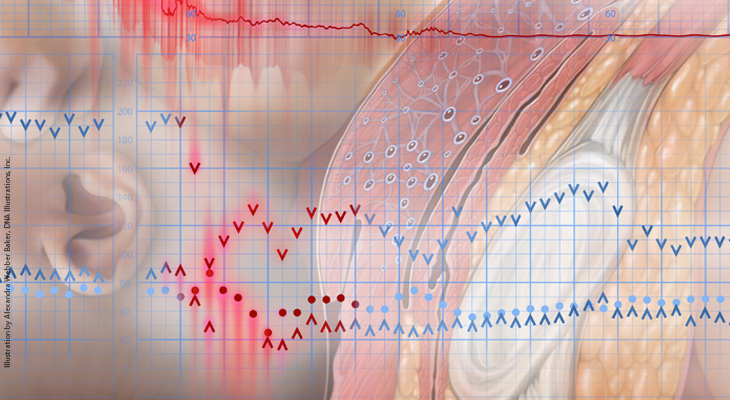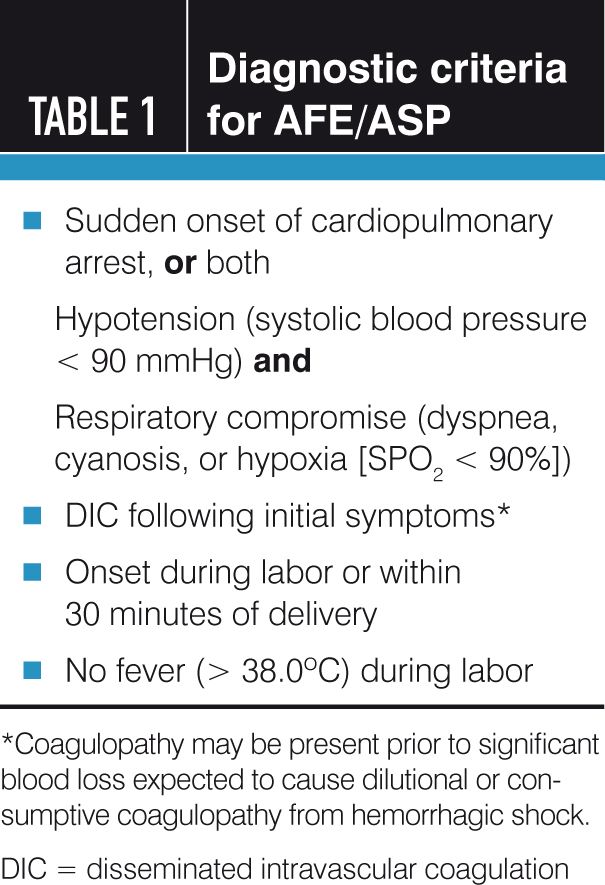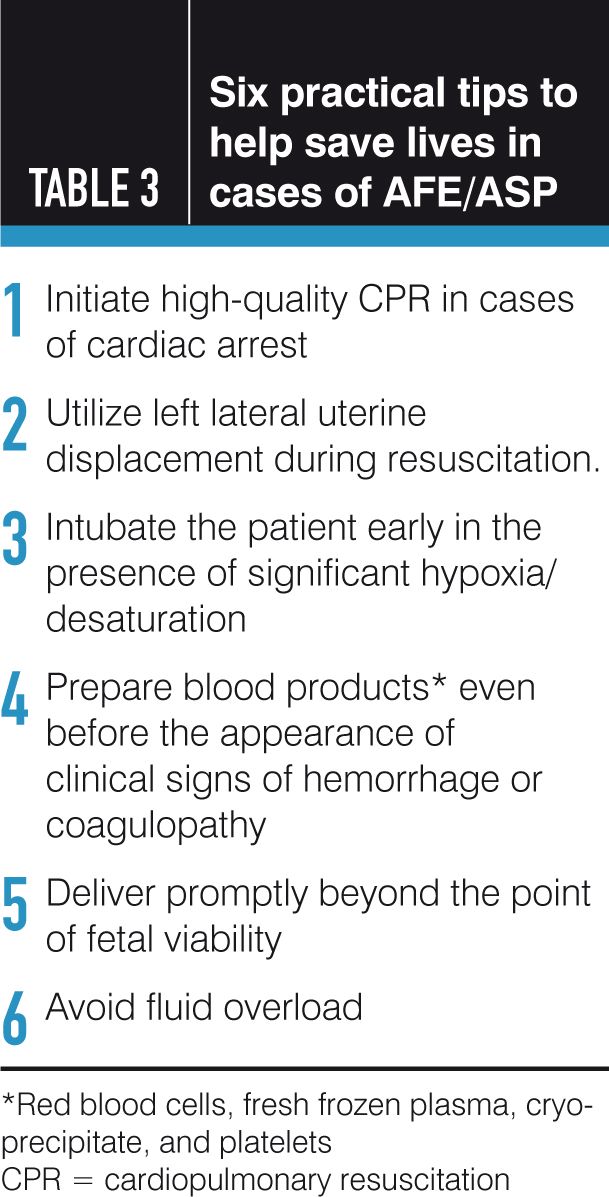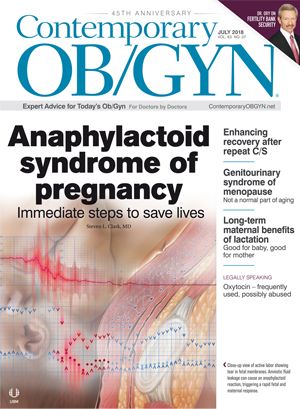Managing obstetric emergencies: Anaphylactoid syndrome of pregnancy (aka AFE)
Ob/gyns must be ready to move quickly when a patient exhibits the sudden and unexpected signs of anaphylactoid syndrome (ASP).
Illustration by Alexandra Webber Baker, DNA Illustrations Inc. Click here to see more of her work.

Anaphylactoid syndrome of pregnancy (ASP) remains a puzzling and deadly condition despite decades of recognition and research. It is a leading cause of maternal mortality,1 yet it likely has been overdiagnosed, with many unexplained peripartum maternal deaths historically attributed to ASP. The aim of this discussion is to shed light on more recent research and our current understanding of this life-threatening obstetric emergency.
Typical presentation

Women with ASP may present with the classic triad of hypoxia, hypotension, and coagulopathy resulting in sudden cardiovascular collapse or cardiac arrest.2 In less typical cases, one or more of these signs may be blunted or absent. ASP usually occurs during labor or within minutes of delivery, either vaginal or cesarean. Patients may experience symptoms of anxiety, a sense of impending doom, confusion, or shortness of breath which are accompanied by abnormal vital signs (Table 1), loss of consciousness, or cardiopulmonary arrest.2,3 Seizures may also occur with this condition, which may be mistaken for eclampsia. Fetal heart rate (FHR) tracing and uterine contraction monitoring may reveal uterine tachysystole as a direct result of maternal catecholamine release; this initial shock reaction also includes shunting of uterine blood from the uterus and placenta to transiently maintain blood pressure and perfusion of maternal vital organs. Both of these processes result in signs of fetal hypoxia and FHR abnormalities, which often precede maternal cardiopulmonary manifestations.
Coagulopathy is also a major component of classic ASP, although some patients may expire before their clotting status can be assessed. Disseminated intravascular coagulation (DIC) can result in massive hemorrhage and may be detected clinically by bleeding from the vagina, during cesarean, or from the incision postoperatively, intravenous sites or the bladder (hematuria.) In the acute care setting, presence of coagulopathy may be the only clinical feature distinguishing ASP from massive pulmonary embolism; however, the latter occurs primarily in the postpartum period whereas ASP is primarily an intrapartum condition.
Etiology and mechanism
Most cases of ASP occur peripartum, during labor (70%) or within minutes of delivery (30%).4 Originally, it was hypothesized that fetal squamous cells entering the maternal circulation and obstructing the pulmonary vascular tree were responsible for the hemodynamic manifestations of this condition. This was based on autopsy reports of eight women who died during labor in whom such squamous cells were identified.5 Based on this presumed pathophysiologic mechanism, this syndrome was originally designated amniotic fluid embolism but it is now known as anaphylactoid syndrome of pregnancy (ASP). This is because we now have an improved understanding of the pathophysiology of the condition, based on recent research.2,4
Subsequent studies demonstrated presence of squamous cells in pregnant women with other conditions, and the clinical similarity of this condition to other manifestations of the systemic inflammatory response syndrome (SIRS) cast doubt upon the theory involving squamous cells.6 Recent evidence also demonstrates that an insufficient number of squamous cells exist in amniotic fluid to cause any significant obstruction of the pulmonary vasculature, even were the entire content of the term amniotic cavity infused into the maternal circulation.7
Because the clinical picture of ASP mimics an allergic or proinflammatory reaction, and it occurs at the time when fetal tissue is likely to enter the maternal circulation, it appears that the mechanism of ASP involves an abnormal host (maternal) immunological response to a common physiologic phenomenon. Specifically, fetal antigens enter the maternal circulation during labor or delivery and elicit a proinflammatory response driven by endogenous mediators including cytokines. This SIRS-like process may include pulmonary vasoconstriction, direct pulmonary injury and capillary leak (acute respiratory response syndrome) and depression of myocardial contractility. DIC and hemorrhage are downstream effects of systemic activation of inflammatory mediators and the coagulation cascade. Unfortunately, at present there are no identifiable clinical risk factors for pre-labor identification of at-risk maternal-fetal pairs nor are there any preventative measures for ASP.
Diagnosis
In the past, diagnosis of ASP was commonly made at the time of autopsy when fetal squamous cells were detected in the maternal pulmonary circulation. In fact, in some countries, the case definition of ASP still includes pathological diagnosis of fetal squamous cells/debris in the maternal pulmonary circulation, despite clear evidence that this finding is non-diagnostic.2,4,6,8,9

We support the recommendation of the Society for Maternal-Fetal Medicine (SMFM) that ASP is a clinical diagnosis and often one of exclusion, involving elimination of other more common causes of maternal cardiovascular instability or coagulopathy. (Table 2).10 A multispecialty expert panel including representatives of the Society for Maternal-Fetal Medicine, the National Institutes of Health and the Centers for Disease Control have published a set of diagnostic criteria for AFE for use in development and evaluation of studies of AFE/ASP (Table 1).10 These criteria were developed to address the problem of a body of existing literature heavily populated with patients who did not actually have ASP. Such errors have contributed to confusion and misunderstanding regarding the nature of this condition, risk factors and prognosis.
Retrospective review of cases of suspected AFE/ASP by experts have found that up to 50% of cases coded as AFE/ASP have other more likely diagnoses, making use of population-based studies derived from administrative coding data particularly problematic.11 These criteria have been validated; while their use will reliably exclude women without ASP from research databases, they will also exclude a small number of women with atypical presentations of this condition.12
Prognosis and recurrence
Reported mortality from ASP/AFE has decreased significantly over the last several decades, in part due to recognition of the existence of less severe, atypical presentations. Recent reports suggest a survival rate of up to 80%.13 However, heavy contamination of administrative coding-based studies with patients who do not have this condition suggest caution in interpretation of such mortality data. In reports based on actual medical records review by experts in critical care obstetrics, both incidence of ASP and survival rates are generally lower.2,11 In women whose initial presentation includes cardiopulmonary arrest, prognosis remains poor. After recovery from hemodynamic derangements and coagulopathy, many patients will have acute lung injury/acute respiratory distress syndrome. Hypoxic brain injury may also be sustained due to the initial severe hypoperfusion and hypoxia. Echocardiography may reveal evidence of right ventricular overload and dilation, pulmonary artery hypertension, and contractile dysfunction of the left ventricle.14-16 Risk of recurrence with ASP is unknown, however, to date no recurrences have been reported. Given the apparent uncommon and unique interaction between patient and fetus-specific antigen involved in this condition, recurrence would not be expected with a different fetus.

Management strategy
When faced with sudden peripartum cardiopulmonary collapse or suspected ASP, the obstetrician’s initial role is to recognize the various possible etiologies. If ASP is suspected based on the triad of hypoxia, hypotension, and coagulopathy in addition to timing around time of delivery, the first step is to provide high-quality cardiopulmonary resuscitation (CPR) as indicated (Table 3).
Treatment is primarily supportive. An important concurrent step is to ask for help from team members including nursing, obstetrics partners or maternal-fetal medicine experts, anesthesia personnel, critical care personnel, and the blood bank. Left lateral uterine displacement, or in a potentially viable fetus (≥ 23 weeks’ gestation) delivery during resuscitation efforts may increase cardiac preload and improve the effectiveness of CPR by relieving inferior vena cava pressure caused by the gravid uterus. Intubation will likely be needed for ongoing respiratory support. Even prior to clinical signs of hemorrhage, we recommend notifying the blood bank and perhaps activating a massive transfusion protocol if suspicion for ASP is high as at least 80% of these women will develop DIC.4 Based on the presumed pathophysiology of ASP, a novel regimen of atropine, ondansetron and ketorolac has been proposed.17 Although survival with use of this regimen has been described and may reasonably be incorporated into standard treatment approaches for ASP, its actual efficacy is uncertain.
The Amniotic Fluid Embolism Foundation, a unique collaboration between private and academic institutions, has been established both to assist patients and families who have encountered ASP and to promote research efforts. Information regarding participation in an ongoing national registry of ASP cases is also available through the foundation website, at https://www.afesupport.org/.
Illustration by Alexandra Webber Baker, DNA Illustrations Inc. Click here to see more of her work.
Disclosures:
The author reports no potential conflicts of interest with regard to this article.
References:
- Chang J, Elam-Evans LD, Berg CJ, et al. Pregnancy-related mortality surveillance--United States, 1991--1999. MMWR Surveill Summ. 2003;52:1-8.
- Clark SL. Amniotic fluid embolism. Obstet Gynecol. 2014;123:337-48.
- Ecker JL, Solt K, Fitzsimons MG, MacGillivray TE. Case records of the Massachusetts General Hospital. Case 40-2012. A 43-year-old woman with cardiorespiratory arrest after a cesarean section. N Engl J Med. 2012;367:2528-36.
- Clark SL, Hankins GD, Dudley DA, Dildy GA, Porter TF. Amniotic fluid embolism: analysis of the national registry. Am J Obstet Gynecol. 1995;172:1158-67; discussion 67-9.
- Steiner PE, Luschbaugh CC. Maternal pulmonary embolism by amniotic fluid. JAMA. 1941;117:1245-51.
- Clark SL, Pavlova Z, Greenspoon J, Horenstein J, Phelan JP. Squamous cells in the maternal pulmonary circulation. Am J Obstet Gynecol. 1986;154:104-6.
- Funk M, Damron A, Bandi V, Aagaard K, Szigeti R, Clark S. Pulmonary vascular obstruction by squamous cells is not involved in amniotic fluid embolism. Am J Obstet Gynecol. 2018;218:460-1.
- Royal College of Obstetricians and Gynecologists. UK Obstetric Surveillance System Amniotic fluid embolism. Available at: https://www.npeu.ox.ac.uk/ukoss/current-surveillance/amf. Accessed May 23, 2018.
- Australasian Maternal Outcomes Surveillance System Amniotic fluid embolism. Available at: http://www.amoss.com.au/?q¼content/amniotic-fluid-embolism-afe. Accessed May 23, 2018.
- Society for Maternal-Fetal Medicine. Electronic address pso, Pacheco LD, Saade G, Hankins GD, Clark SL. Amniotic fluid embolism: diagnosis and management. Am J Obstet Gynecol. 2016;215:B16-24.
- Clark SL, Romero R, Dildy GA, et al. Proposed diagnostic criteria for the case definition of amniotic fluid embolism in research studies. Am J Obstet Gynecol. 2016;215:408-12.
- Stafford I, Moaddab A, Klassen M et al. Diagnostic precision of proposed criteria for research reporting of amniotic fluid embolism. Am J Obstet Gynecol. 2018;218: S122-123.
- Knight M, Tuffnell D, Brocklehurst P, Spark P, Kurinczuk JJ, System UKOS. Incidence and risk factors for amniotic-fluid embolism. Obstet Gynecol. 2010;115:910-7.
- McDonnell NJ, Chan BO, Frengley RW. Rapid reversal of critical haemodynamic compromise with nitric oxide in a parturient with amniotic fluid embolism. Int J Obstet Anesth. 2007;16:269-73.
- James CF, Feinglass NG, Menke DM, Grinton SF, Papadimos TJ. Massive amniotic fluid embolism: diagnosis aided by emergency transesophageal echocardiography. Int J Obstet Anesth. 2004;13:279-83.
- Evans S, Brown B, Mathieson M, Tay S. Survival after an amniotic fluid embolism following the use of sodium bicarbonate. BMJ Case Rep. 2014;2014.
- Rezai S, Hughes AC, Larsen TB, Fuller PN, Henderson CE. Atypical amniotic fluid embolism managed with a novel therapeutic regimen. Case Rep Obstet Gynecol. 2017; published online dec 21 2017.

S1E4: Dr. Kristina Adams-Waldorf: Pandemics, pathogens and perseverance
July 16th 2020This episode of Pap Talk by Contemporary OB/GYN features an interview with Dr. Kristina Adams-Waldorf, Professor in the Department of Obstetrics and Gynecology and Adjunct Professor in Global Health at the University of Washington (UW) School of Medicine in Seattle.
Listen
Similar delivery times between misoprostol dosages among obese patients reported
May 29th 2024A recent study found that obese patients undergoing induction of labor experienced similar delivery times regardless of whether they received 50 μg or 25 μg of vaginal misoprostol, though multiparous patients showed faster delivery with the higher dosage.
Read More
Buprenorphine use in pregnancy linked to decreased fetal breathing movements
May 18th 2024According to a poster presented at ACOG 2024, use of the synthetic opioid buprenorphine depressed fetal breathing in biophysical profile assessments, but had no significant impact on other factors like amniotic fluid index or fetal tone.
Read More
